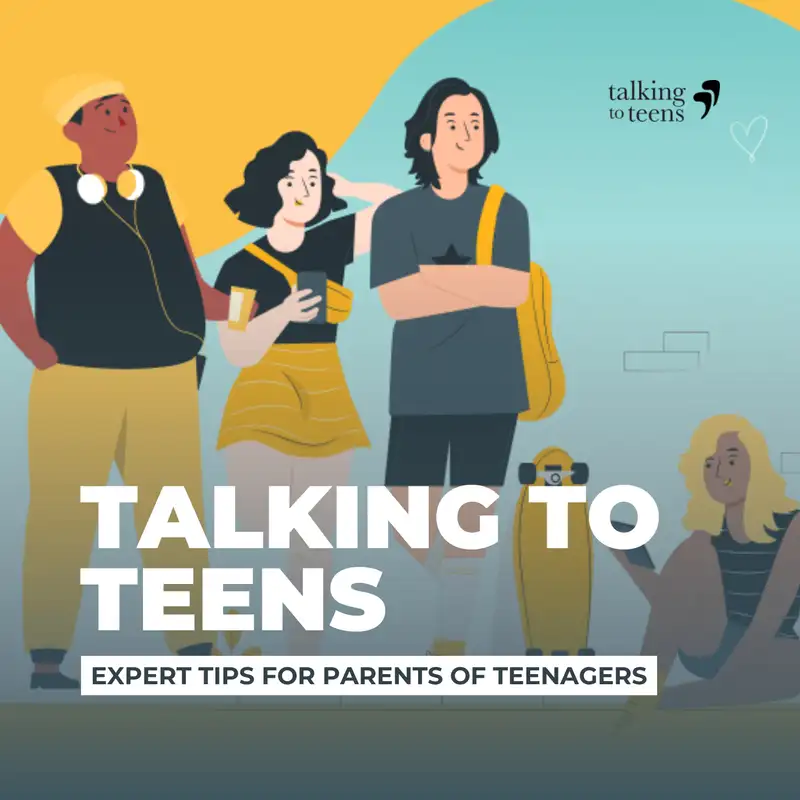Ep 68: What You Don't Know About Teen Hook-up Culture
Peggy Orenstein, author of Boys & Sex, a current New York Times Bestseller (as well as several other bestsellers!), joins Andy for an in-depth conversation about the culture of sex, intimacy, and relationships that teens are facing and which conversations are crucial to have with your teens - despite how awkward it may be!
Full show notes
Teenage hookup culture is dangerous. And while most parents are aware of how scary and confusing it is for girls, society at large is neglecting a significant percentage of the participants: boys.
Full show notes
Teenage hookup culture is dangerous. And while most parents are aware of how scary and confusing it is for girls, society at large is neglecting a significant percentage of the participants: boys.
Despite what social norms generally say about boys, young men have feelings too. Unfortunately, media and male role models are rarely depicted as anything but macho, “strong,” assertive, and sexually dominant. While parents may encourage their girls to play sports and stand up for themselves, it is still taboo to encourage teen boys to dance, craft, or be vulnerable. These cultural norms can have a huge impact on teen behavior across the gender spectrum, especially when it comes to (teenage hookup culture) their sexuality. Luckily, there are proven ways to mitigate harmful behavior.
But norms are pervasive, and sending negative messages according to the gender binary, overt or subliminal, about how adolescents are supposed to act hurts everyone. Teen boys are “supposed” to be aggressive, impersonal, and sexually dominant. Girls face conflicting messages, locked into submissive, inanimate, prude, and sexually alluring roles. These messages create harmful expectations and behaviors, and when put to the test in today’s teenage hookup culture, your child could face the consequences. That’s why the focus of our Talking to Teens podcast this week is “What You Don’t Know About Teenage Hookup Culture.”
This week, New York Times bestselling author, Peggy Orenstein, joins me for a candid discussion about her collection of books on teenage hookup culture. Her latest book, Boys & Sex: Young Men on Hookups, Love, Porn, Consent and Navigating the New Masculinity (2020), explores how young men understand and negotiate the new rules of physical and emotional intimacy. It follows on the heels of Orenstein’s second foray into teen hookup culture from women’s perspectives, Girls & Sex: Navigating the Complicated New Landscape (2016).
Peggy conducted research for Boys and Sex through qualitative interviews about teen experiences with sexuality. She found that open communication and education about healthy sexual relationships mitigates the harmful behavior of teenage hookup culture. This works primarily by:
- Subverting Harmful Messaging
- Prioritizing Your Teen’s Safety and Happiness
- Promoting Mutual Empathy in Relationships
In the podcast, Peggy clued me in on how communication can be used to apply these virtues in successful parenting scenarios. We also discuss the gripping revelations from her other books, Schoolgirls (1995), Flux (2001), and Cinderella Ate My Daughter 2012. Her research is so important to the wellbeing of young adults navigating today’s teenage hookup culture that parents should absolutely hear what she has to say in detail. Here’s just a hint at her findings:
How Much Do You Know About Teenage Hookup Culture?
Teenage hookup culture is the social behavior of encouraging casual sex encounters. This practice isn’t inherently bad, but it is largely informed by harmful messaging about gender roles. One negative aspect of this messaging that Peggy’s books address is the emotional vacancy that boys are encouraged to adopt as part of their sexuality.
The reason teenage hookup culture tells boys to reject intimacy is to take ownership of the people they have sex with. In movies and TV shows, the cool characters are often portrayed as womanizers or men with a long sexual history, highlighting their emotional callouses. These messages make it so that sex is about building social capital rather than empowering a partner and yourself. However, sex is an intimate act and is personal by nature. This is why teens turn to alcohol for a dangerous buffer to their emotions and general cognition.
In our conversation, Peggy notes that teenage hookup culture is dependent on alcohol to create the sense of “compulsory carelessness.” When teens are urged to make their sexual relationships feel meaningless and treat them like commodities, they often turn to alcohol to numb their authentic selves. This dynamic can lead to substance abuse, violent relationships, and emotional trauma for the people involved.
So how can parents mitigate these behaviors?
The Benefits of Open Communication
Communicating openly is an opportunity for you to directly address the messages of teenage hookup culture that often conflict with teen’s emotional wellbeing. More than just the “birds and the bees” discussion or relaying the negative aspects of sexuality, teens should be encouraged to speak openly about their interests and inexperience.
When we talk to our kids about sex, particularly girls, it’s usually in a protective context. We do this because we recognize how teenage hookup culture cultivates a destructive narrative around sexuality. One way that parents can undermine this narrative is by addressing locker room talk.
Locker room talk is a perfect example of how these messages become ingrained in young adults. It’s also why male parents are commonly overprotective of their daughters. They know how women’s bodies and sexuality are discussed and naturally wish to protect their daughters from encountering such harm. But this toxic behavior also makes it so that boys cannot express their concerns about sexuality. As Peggy details in her book, boys that felt uncomfortable with the aggressive attitude of locker room talk were pressured into conformity.
As it turns out, boys are as equally confounded as their female peers when it comes to sex, intimacy, and relationships. Almost all the information we give teens about sex is risk-based; that is, we tell our teens all the “bad” things that might happen, such as diseases, sexual assault, rape, pregnancy, and skip out on everything else. These messages, combined with the vernacular of locker room talk, create a very hostile perception of what sex is like.
Parents can mitigate the harmful behavior of teenage hookup culture by creating a safe and secure space for teens to talk about their concerns. When teenagers feel like they have a trusted confidante to talk about these intimate matters, they’re more likely to ask genuine questions about teenage hookup culture and the kinds of activities that would feed a positive relationship.
If teens don’t know what kind of healthy practices exist, how would they know to engage in them? Instead, they’d be left to emulate what teenage hookup culture prescribes as the only way to engage romantically. This is why it’s important for parents to provide alternatives, like in-depth examples of safe practices that aren’t discussed in sex education courses or in locker rooms.
One fascinating study in Peggy’s book compares differences in the way the U.S. educates their teenagers about sex verses what young adults in Holland are taught. She says that Dutch teens have candid conversations with their parents, teachers, and doctors, creating open communications about both dangerous and healthy aspects of sexuality. In fact, they frame their candid relationships as “cozy togetherness,” a culture wherein teens don’t have to hide aspects of themselves in order to become adults. As a result, teens had fewer negative consequences like pregnancy, disease, or intoxicated interactions and instead enjoyed their experiences more.
To hear about how Safety and Empathy play into communicating with teenagers, don’t forget to listen to the whole episode!
Peggy and I discuss how we got here and what parents and educators can do to make things better. We cover:
- What’s missing in our talks with teen’s about sex
- The dreaded sleepover and why it can be a great way to keep your teens safe
- Why it’s so hard for boys to stand up against other boys’ bad behavior
- The big disconnect between girls acting “sexy” before truly understanding what sexy means
Peggy is a wealth of knowledge and I was blown away by her body of work on gender, women, and the landscape of teenage hookup culture. Her insights are sometimes funny, sometimes disheartening…but they are always powerful!
Prioritizing Safety
- Rather than learning through harmful behavior, they can learn about positive sexual experiences that inform them about healthy practices. How can your teen explore healthy and fulfilling options that prioritize their safety and wellbeing if they don’t know they exist? Educating your teen about positive experiences will familiarize them with boundaries and goals.
- According to ___, one way that you can create a safe environment for your teen to explore sexuality is during a sleepover. Now, we know what you’re thinking: “I’m never going to let this happen! That’s exactly what I’m trying to avoid!” But if teenagers are old enough to explore their sexuality, they’re old enough to find a way to experiment one way or the other. It’s like using alcohol: wouldn’t you want your teen to be in a safe and controlled environment instead of one where they could potentially get hurt while they’re on their own? Soft Power. A sleepover affords you the opportunity to acknowledge what is going on with your teen and educate them about responsibility and safe sex.
Open communication also works to create a more empathetic and understanding environment about sexuality
- Empathy and Understanding undercut harmful messaging by helping your teen understand the perspectives of their potential partner. Building intimacy and negating the objectifying practices of hookup culture.
- Peggy says it helps raise guys to be their best self, fuller human beings.
- A notable practice in the book was for the kids to read people’s perspective from different genders.
- If they now how the other person is feeling and gets to adopt their experiences, they’re more likely to reject the harmful messaging and explore their own joys and happiness with their partner(s).
How to address it.
- It can be awkward and terrible. In the podcast, we talk about many ways to address it. One of which is redirecting the role of educator/conversationalist to someone else. This should be someone that you trust and can relay the messages you want your child to know about. Candidates include:
- Aunts or Uncles
- Older Cousins
- Older Siblings
- Young adults in your child’s age range who are older family friends
- Peggy says that you can even direct your child to a source of information that teaches about dangers as well as positive and safe sex practices to mitigate harm of teenage hookup culture. That’s why she provides all the tips and practices that she’s gathered throughout her research on her website as a resource for parents and teens to look into. You can check them out at their Website.
- To get the full collection of effective ways to address sexuality with your teens, be sure to listen to the full podcast.
When we forget to (or purposely leave out) talking to our teens about what healthy, normal, intimate relationships look like, we are letting everyone else decide for them. The media, magazines, YA fiction, Netflix, and Hollywood (not to mention the pornography industry) decide “roles” for our teen girls and boys to play. Is it any wonder that young people, afraid of intimacy, lubricate their sexual interactions with alcohol?
Creators and Guests

Guest
Peggy Orenstein
Author, "Unraveling" (available 1/24/23!), "Boys & Sex," "Girls & Sex," "Cinderella Ate My Daughter," etc.


